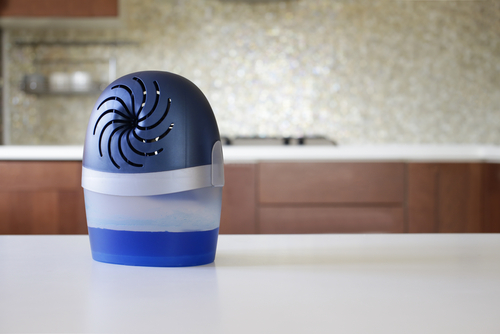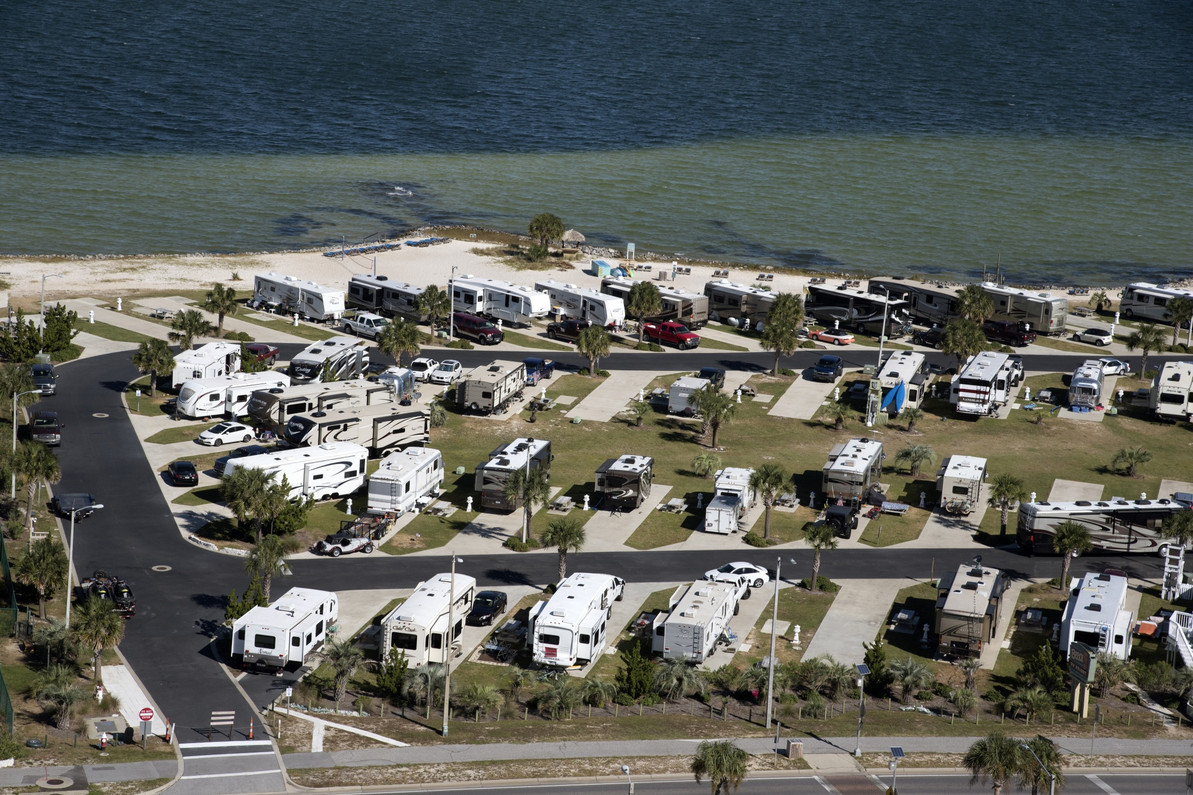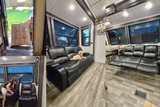Humidity Troubles?
If you travel in your RV during the summer months, you have likely experienced the struggle of trying to control humidity levels inside of your rig. It can be a frustrating battle between comfortable temperature, acceptable humidity levels, and energy usage. RVs are especially prone to high interior humidity levels due to various factors, such as insulation rating, building materials, and size.

The importance of controlling humidity levels in your RV cannot be overstated. Consistently high humidity levels enable mold to grow in susceptible areas such as your walls, ceilings, subflooring, and even mattress. As I’m sure you can guess, repairing or replacing structural components of your motorhome is no small expense. Also, we are likely all aware of just how uncomfortable high humidity levels are when it is hot outside. Beyond the health of your RV, controlling humidity levels is also imperative for your personal comfort.
There are some small things you can (and should) do to help reduce the humidity in your rig, but in certain conditions, these little changes may not be enough. Suppose you are trying to lower the humidity level in your rig. In that case, you can try cooking and doing laundry outside when possible, increasing the airflow within your RV, and using moisture absorbers.

Running your air conditioning is often the most effective way to reduce humidity levels within your rig, but keep in mind that this is not the primary function of your A/C unit. The drop in humidity that happens when you turn on your A/C is a byproduct of the cooling process and thus is limited by that same process. So, if the air temperature in your RV hits the low end of the temperature control range, your A/C unit cannot work to bring that temperature any lower. If your A/C is not working to cool, it is no longer working to reduce humidity levels either.
In areas like Florida at night, your A/C unit may be able to reach the coolest operating temperature rather quickly once the sun goes down and the outside temperature drops. However, moisture levels in the air stay pretty consistent throughout the night, with relative humidity actually rising due to the decrease in temperature. Relative humidity measures how much moisture is in the air compared to how much moisture the air can hold at a given temperature. The air can hold much more moisture in higher temperatures than in lower temperatures, which is essential to keep in mind when managing humidity.
If you are taking steps to reduce humidity levels in your rig and are running your air conditioner at max capacity but are still experiencing difficulties, it may be time to consider a dehumidifier. In the following section, we will discuss the types of dehumidifiers and how they work in more detail.
How Do Dehumidifiers Work?
There are technically two types of dehumidifiers; those that use refrigeration to force condensation to occur and those that use absorption/adsorption to trap water from the air using a desiccant.
Refrigerant Dehumidifier

Refrigerant dehumidifiers, also known as compressor dehumidifiers, remove moisture from the air in a manner similar to air conditioners. When warm, moist air enters either of these systems, it must pass over a set of chilled coils. As this happens, heat energy from the air wants to move into the coils because that’s where the energy is the lowest. In our “Get to Know the RecPro Quiet AC Units by Houghton” article, we discuss in more detail how and why energy transfer occurs, so if you are interested in learning more on that topic, go check out the article after this one. For refrigerant dehumidifiers, though, all you need to know is this process strips moisture from the ambient air in your space, and that moisture is contained within the closed system.
At this point, air conditioners would continue through a closed cycle to disperse the heat energy and recirculate cooled air into your space. Refrigerant dehumidifiers do not do this. Instead, the cool, dry air is sent over warm coils to bring the air back to the original temperature, which is then returned directly back into your space. Refrigerant dehumidifiers remove moisture from the air while keeping the temperature relatively constant.
Desiccant Dehumidifier
Instead of relying on condensation to reduce humidity, desiccant dehumidifiers use a hygroscopic chemical to remove moisture from the air through adsorption. Adsorption is when individual molecules, atoms, or ions adhere to a surface. Adsorption differs from absorption because absorption is when a fluid is fully dissolved or permeated into another substance. With adsorption, the air’s water molecules stick to the desiccant’s surface, but the air itself passes through. The types of desiccant dehumidifiers range from disposable single-use products to residential-grade powered appliances.

Disposable Desiccant Dehumidifiers (Moisture Absorbers)
If you are familiar with the silica gel packets that come in items like pill packaging and beef jerky, these are an example of desiccant dehumidifiers. These packets contain a chemical that draws in moisture from the surrounding air. Similar products are available for use in your RV. Disposable moisture absorbers are not nearly as efficient at removing water as any powered appliance designed to do the same thing. Still, they are inexpensive, disposable, and don’t drain any of your (often) limited power supply.
Rechargeable Desiccant Dehumidifiers
Rechargeable desiccant dehumidifiers have a similar moisture removal rate as disposable moisture absorbers, but, as the name suggests, these units can be recharged for continued use. However, in this case, recharging means freeing the moisture that has accumulated in the desiccant. The electrical current passing through the device is not stored in a DC battery but instead is applied as heat to the desiccant so that the moisture is forced out. Because of this, you should always recharge these devices outside or in a well-ventilated space, or else you will add moisture to the area you are trying to dehumidify.
Powered Desiccant Dehumidifier
While the other two types of desiccant dehumidifiers on this list are inexpensive and convenient, they will likely not be able to remove enough moisture or work quickly enough to make a noticeable difference in your RV. That’s not to say they don’t work great for small spaces, such as a bathroom or closet.
Powered desiccant dehumidifiers utilize a spinning wheel to adsorb moisture from the air stream, which is then dried out from the system as the wheel spins. The air re-entering your space from the desiccant dehumidifier will be slightly warmer than the air that entered because warm air is used to help the spinning wheel dry.
Comparing Refrigerant and Powered Desiccant Dehumidifiers
As with all household appliances, every available option has pros and cons. Because of cost and effectiveness, refrigerant dehumidifiers are typically seen in RVs more often than desiccant dehumidifiers. Still, there are certain cases where a desiccant dehumidifier may be the better option.

Efficiency
Refrigerant dehumidifiers are more efficient at removing moisture from the air than desiccant dehumidifiers, meaning they can remove larger amounts at a quicker rate while using less energy.

Cost
The cost breakdown between these two types of dehumidifiers is not straightforward, but refrigerant dehumidifiers are the more cost-friendly option from an initial cost and energy standpoint. However, desiccant dehumidifiers often require less maintenance and have a longer lifespan, so the costs may even out eventually.

Noise Levels
Refrigerant dehumidifiers can be quite noisy due to the presence of an internal compressor. Desiccant dehumidifiers are much quieter.

Climate
Refrigerant dehumidifiers can only function if their internal temperature is lower than the room temperature, which, depending on the climate you live in, may not be the most effective option. Desiccant dehumidifiers perform consistently no matter the temperature.
Closing Thoughts
Struggling to dial in the humidity in your RV isn’t only uncomfortable for you and can also be detrimental to your rig in the long run. An effective way to address this is by adding a dehumidifier that works independently to remove moisture from your space. Even though RV air conditioners work to do this as well, it is not a primary function and thus cannot be controlled independently.
Are you curious if adding a dehumidifier is the right choice for you? Let us know your questions or concerns about dehumidifiers in the comments below!
Recent Posts
-
Traveling to the RV Hall of Fame in Elkhart, IN
If you are traveling to Elkhart, IN to see the RV Hall of Fame, getting off the toll road at exit 96 …Nov 14, 2025 -
Best RV Air Conditioners of 2025: An Expert Guide From RecPro
Quick Answers Best overall RV air conditioner: RecPro 15K Quiet AC with Heat Pump (RP-AC3800) Best f …Oct 29, 2025 -
The Nuclear Nomads Expand Sofa with New Recliner Section Install
The Nuclear Nomads are a full time RV family living in south Florida. Andi and Joey value quality ti …Oct 24, 2025 -
Trailer Wiring Guide: How to Wire Your Trailer for Safety and Efficiency
Table of Contents 1. Common Types of Trailer Connectors 2. Trailer Wiring Diagrams: Color Codes and …Aug 20, 2024 -
How to Keep Your Pets Safe While Camping
RVing and camping are a great getaway from the hustle and bustle of work and the city and the day-to …Jul 02, 2024 -
Why Replace Your RV Furniture?
You may wonder when is the best time to replace your RV furniture. There is no one right answer to t …May 20, 2024







